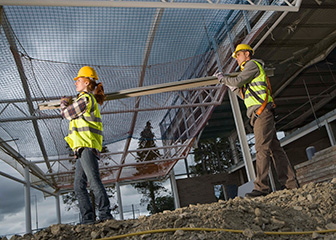How to Become a Construction Laborer or Helper About this section

Laborers often start by performing simple cleaning duties.
Most construction laborers and helpers learn their trade through short-term on-the-job training.
Although there are no formal educational requirements, high school classes in English, mathematics, blueprint reading, welding, and shop can be helpful.
Training
Most construction laborers and helpers learn through short-term on-the-job training after being hired by a construction contractor or a temporary-help employment agency. Workers typically gain experience by doing jobs under the guidance of experienced workers.
Although the majority of workers learn informally, some opt for formal apprenticeship programs. Programs generally include 2 to 4 years of technical instruction and on-the-job training. In the first 200 hours, workers learn basic construction skills, such as how to read blueprints, the correct use of tools and equipment, and safety and health procedures. The remainder of the curriculum consists of specialized skills training in three of the largest segments of the construction industry: building construction, heavy and highway construction, and environmental remediation such as lead or asbestos removal.
Several groups, including unions and contractor associations, sponsor apprenticeship programs. The basic qualification for entering an apprenticeship program is being age 18 or older. A high school diploma or its equivalent is preferred but not required.
Education
Although there are no formal educational requirements, some workers may choose or be required to attend a trade or vocational school, association training class, or community college to get further trade-related training.
Licenses
Laborers who remove hazardous material (hazmat) must have a federal hazmat license. For more information, see the profile on hazardous materials removal workers.
Certification
Depending on the work they do, laborers may need specific certifications. Certification helps workers prove that they have the knowledge to perform more complex tasks.
The following are examples of areas which my require certification:
- Asbestos
- Energy Auditor
- Lead
- Operators Qualification for Pipeline
- OSHA 10 and/or 30 Hour Construction Safety Certification
- Radiological Worker
- Rough Terrain Forklift Operation
- Scaffold User and Builder
- Signalperson Qualification
- Weatherization Technician Installer and Supervisor
- Welder
- Workzone Safety Technician, Flagger and Supervisor
Advancement
Through experience and training, construction laborers can advance into positions that involve more complex activities. For example, laborers may earn certifications in welding, scaffold erecting, or concrete finishing and then spend more time performing activities that require the specialized knowledge.
Through training and experience, helpers can move into construction craft occupations. For example, a bricklayer’s helper may have a chance to set bricks on the job and later join the contractor’s apprenticeship program.
Important Qualities
Color vision. Laborers and helpers may need to be able to distinguish colors to do their job. For example, an electrician’s helper must be able to distinguish different colors of wire to help the lead electrician.
Math skills. Laborers and some helpers need to perform basic math calculations to do their job. They often help with measuring on jobsites and may be part of a surveying crew.
Physical strength. Laborers and helpers often must lift heavy materials or equipment. For example, cement mason helpers must move cinder blocks, which weigh more than 40 pounds each.
Stamina. Laborers and helpers must have endurance to perform strenuous tasks throughout the day. Highway laborers, for example, spend hours on their feet—often in hot temperatures—with few breaks.
Technical skills. Laborers frequently are required to operate heavy equipment, such as driving a forklift.













